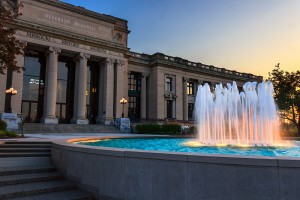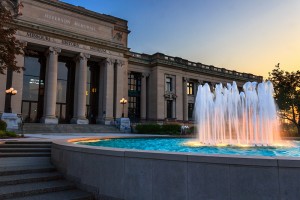
It seems today that in pushing the boundaries of immersive design and interactivity American museums are evolving into theatre. Some are even tossing aside the brick and mortar altogether. Merriam-Webster defines a museum as, “an institution devoted to the procurement, care, study, and display of objects of lasting interest or value; also: a place where objects are exhibited.” That definition certainly doesn’t seem to comprehensively describe the role of the museum today. That description sounds more like a warehouse of artifacts than a museum. However, it did get me thinking about museums and their evolution.
The Museum at Alexandria was built some time around 300 BC in Egypt. Today it would be considered more a university than a museum. In addition to the famous library, it housed lecture halls and rooms dedicated to the study of astronomy, mathematics and anatomy. It was even home to a collection of exotic animals. Archimedes and Euclid are just two of Alexandria’s most notable alumni. This incarnation of the museum was clearly intended to educate and enlighten.
The first public museums began to pop up in Rome during the Renaissance but really flourished in the 18th century. The British Museum featured the personal collection of Sir Hans Sloane. In addition to inventing chocolate milk he was a World traveler who had amassed an extensive collection of artifacts which he bequeathed to the nation of Great Brittan upon his death in 1753. In 1773 the first American museum opened in Charleston, SC. Its focus was local and natural history.
In 1793, during the French Revolution, the Louvre Museum opened in Paris. It originally showcased French royal collections that had been acquired by the monarchy over the course of history. Napoleon saw the role of the museum in a different light. He saw the museum as a political tool. In his eyes the museum was a place to display the conquests of the nation. He believed the common man would look to the museum as a source of patriotism. As Napoleon conquered cities across Europe, the Paris museum collections grew. Although many of his trophies of war were eventually returned to their original owners after Napoleon’s defeat in 1815, the role of the museum had shifted in a new direction. The museum was no longer looked upon as a source of intellectual, spiritual and artistic inspiration. It had become a trophy case to house a collection.
This brings us to Noah Webster. During the early 1800’s Americans were using several variations of the English language. Depending on which part of the country you were in, a single word might have a different spelling, pronunciation or meaning. Some parts of the country were speaking different languages altogether. Webster hoped to unify the country with a standardized American speech reference compendium. In 1828, after 27 years of research and learning more than twenty different languages, Webster published An American Dictionary of the English Language. At the time this dictionary was written, the definition he composed for the word “museum” was probably a fitting description.
By the mid 1800’s a new player had entered the game. After a brief stint in musical theatre, P.T. Barnum purchased his first museum. This young entrepreneur had a flair for theatrics and attention grabbing. No doubt an attribute he developed while writing headlines for the newspaper he founded while still in his early 20’s. His collections were peppered with bizarre objects that satisfied the popular curiosities of the Victorian era. He also clearly recognized that a little bit of theatrics could enhance the typical museum experience. While he was not a pioneer in the realm of academia, he resolutely integrated entertainment into the museum model.
Over the next hundred years museums of all sorts of specialties sprang into existence. Often called the Museum Age, this time period brought us art museums, living history museums, historic house museums, maritime museums, natural history museums, aviation museums, zoos, etc., etc. The list of types of museums is growing everyday. But what is a museum? In Ancient Greece it was a place of spirituality. It became a place of education and enlightenment. Later museums were a source of national pride. In Victorian times the museum was a place to be entertained. Today museums serve the community at many different levels and in many different capacities.
So, how can you define a museum to include its many incarnations and varying roles? Ben Franklin once said that, “words may show a man’s wit, but actions his meaning.” In other words we are defined by what we do. Perhaps this philosophy needs to be applied to museums as well. Museums can no longer be defined by what they are but should be defined by what they do. Every incarnation of every type of museum throughout history had one thing in common. They each told a story. Whether the story is about spirituality, a deity, the stars, mathematics, a Nation or Jo-Jo the Dog Faced Boy is irrelevant. A museum is a place that tells a story. The collections/artifacts are tools that help illustrate the story. The effectiveness with which the museum tells that story is what separates the good museums from the bad.
Follow AST Exhibits on Facebook.
